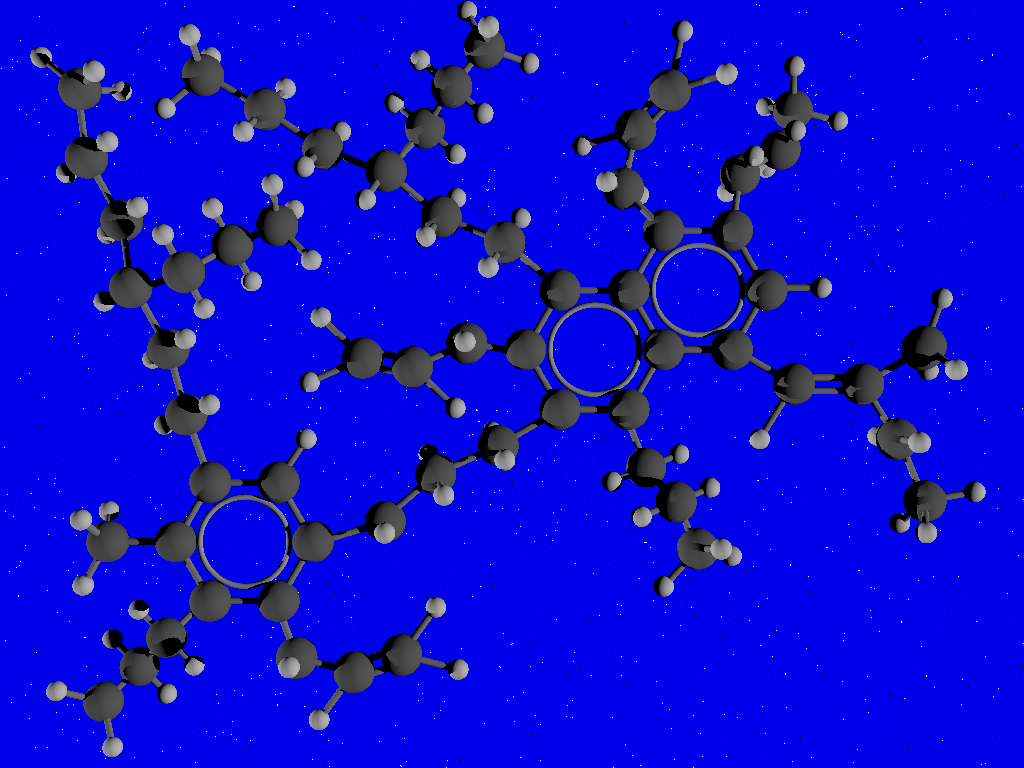Carbonaceous dust
Modelling and laboratory simulation of carbonaceous dust
The first of these spectroscopically-identified dust components shows a series of bands at 3.3, 6.2, 7.7, 8.6, 11.3 and 12.7 micron wavelengths (of the order of a hundredth to a tenth of a micron wide), several other less intense bands and an underlying continuum. The central positions of some of these bands are characteristic of C-H and C-C chemical bonds in materials possessing aromatic structures and indicating a composition indicating a particular family of molecules/nanoparticles, the polycyclic aromatic hydrocarbons (PAHs). The observed bands, the Aromatic Infrared Bands (AIBs), are seen in the majority of astrophysical sources. Their presence in the interstellar medium fundamentally affects the radiative transfer equilibrium. The AIB carriers strongly absorb ultraviolet and visible starlight and re-emit the energy via a vibrational fluorescence mechanism in the infrared. In the process they convert of the order of 20% of the luminous energy of a galaxy but require only 5-10% of the total cosmic carbon abundance in order to do so. Additionally, and because of their abundance, they play an important role in the chemistry of the interstellar medium.
The second spectroscopically-identified component are the bands observed in absorption (dominated by pure absorption) with features at 3.4 and 7.2 microns. It is apparent that the band at 3.4 micron, with its associated substructures, can be identified with methyl and methylene groups in solid carbons. In the Galaxy this dust component represents a large fraction of the cosmic carbon abundance (5-30%) and
is crucial in the evolution of the interstellar medium. High sensitivity observations have opened up a new field of dust research in which the study of dust in absorption in other galaxies is now
possible.
The study of galactic organic matter brings together many fields of research that have in common the objective of understanding, with the help of models, the temporal and spatial evolution of this organic matter in different astrophysical environments. In order to do this we are synthesising analogue materials in the laboratory, i.e., materials composed of structures that are similar to those inferred for interstellar dust. The study of the absorption and excitation properties of such materials aims at reproducing as closely as possible those of interstellar dust, such as hydrogenated amorphous carbons.
In the laboratory we have reproduced probably the best spectroscopic candidate for the interstellar hydrogenated amorphous carbons and, in parallel, we have determined its optical constants and compared it with data from our own observational programs. This has allowed us to derive the expected structure typical of this HAC (see the figure below).

In general, studies of interstellar carbon dust imply aliphatic-rich components and aromatic-rich components, as described above. Note that the compositions and observation conditions of these two hydrocarbon components are completely orthogonal (i.e., aliphatic in absorption and aromatic in emission) and that neither component has yet been well-charaterised observationally. In general, the rather ubiquitous aromatic component must be a PAH-rich phase and models based on PAH molecules are generally coherent with the observational data, to first order. However, difficulties with this hypothesis remain, particularly with regard to the excitation mechanism. The aliphatic component has been much better `modelled' in the laboratory than in any astrophysical model and there are many fewer observations of the aliphatic dust component.
We are thus far from a viable model for carbon dust and its evolution in the ISM. However, we do know that hydrocarbon dust (both aliphatic and aromatic) is formed around C-rich evolved stars, that this dust merges with the ISM through the effects of stellar winds and that in the general ISM it appears to be mostly aromatic-rich. Thus, the aromatic rich component probably represents the stable, end-phase of the hydrocarbon dust evolutionary sequence.
The hydrocarbon dust evolution must include the effects of fragmentation into smaller grains in stellar winds and shock waves and also the effects of UV-visible processing that lead to a decrease in the sp3/sp2 carbon atom ratio (an aromatisation). Models are now needed that take into account this complex evolution of hydrocarbon materials, and our understanding can only advance with a close collaboration between experimentalists, modellers and observers. We are currently trying to develop such models.
Future developments will add to the main research themes of the laboratory (as, for example, laboratory irradiation and sample synthesis using different energy sources in the study of dust evolution in the ISM) and within the framework of the inter-laboratory collaboration between the IAS and the Laboratory for Molecular PhotoPhysics (LPPM) financed by an ANR.



